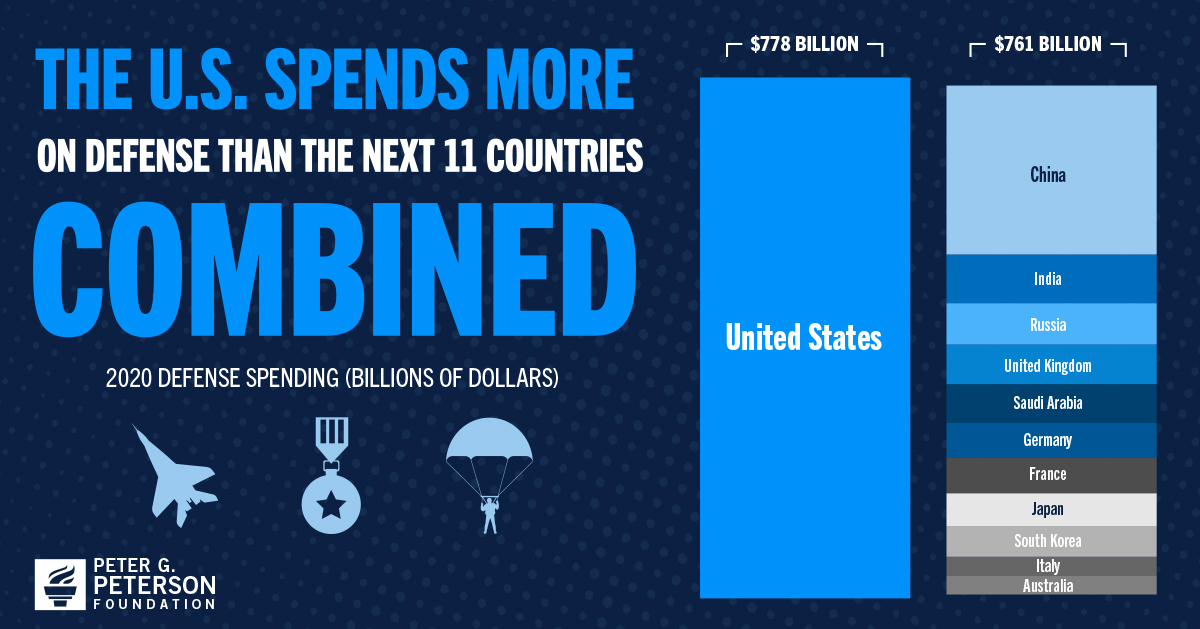
How US Military Spending Works
David Swanson / World BEYOND War
(March 10, 2023) — Here’s how this works each year.
1) Biden proposes a massive increase in military spending — above and beyond both what he proposed the year before and what the Congress increased that to. If you look at US military spending according to SIPRI in constant 2021 dollars from 1949 to now (all the years they provide, with their calculation adjusting for inflation), Obama’s 2011 record will probably fall this year. If you look at actual numbers, not adjusting for inflation, Biden has set a new record each year.
If you add in the free weapons for Ukraine, then, even adjusting for inflation, the record fell this past year and will probably be broken again in the coming year.
You’ll hear all sorts of different numbers, depending on what’s included. Most used is probably $886 billion for what Biden has just proposed, which includes the military, the nuclear weapons, and some of “Homeland Security.”
In the absence of massive public pressure on a topic the public hardly knows exists, we can count on an increase by Congress, plus major new piles of free weapons to Ukraine. For the first time, US military spending (not counting various secret spending, veterans spending, etc.) will likely top $950 billion as predicted here.
War profiteer-funded stink tankers like to view military spending as a philanthropic project to be measured as a percentage of an “economy” or GDP, as if the more money a country has, the more it should spend on organized killing. There are two more sensible ways to look at it. Both can be seen at Mapping Militarism.

One is as simple amounts per nation. In these terms, the US budget is more than those of most nations of the world combined. Only 29 nations, out of some 200 on Earth, spend even 1 percent what the US does. Of those 29, a full 26 are US weapons customers. Many of those receive free US weapons and/or training and/or have US bases in their countries.
Only one non-ally, non-weapons customer (albeit a collaborator in bioweapons research labs) spends over 10% what the US does, namely China, which was at 37% of US spending in 2021 and likely about the same now despite the highly horrifying increases widely reported in the US media and on the floor of Congress. (That’s not considering weapons for Ukraine and various other expenses.)
The other way to look at it is per capita. As with a comparison of absolute spending, one has to travel far down the list to find any of the designated enemies of the US government. But here Russia jumps to the top of that list, spending a full 20% of what the US does per person, while only spending less than 9% in total dollars.
In contrast, China slides down the list, spending less than 9% per person what the United States does, while spending 37% in absolute dollars. Iran, meanwhile, spends 5% per capita what the US does, compared to just over 1% in total spending.
Meanwhile, the list of US allies and weapons customers that lead the rankings (among those nations trailing behind the United States itself) shifts. In more familiar overall terms, we’d be looking at India, Saudi Arabia, France, Germany, UK, Italy, Brazil, Australia, and Canada as the top spenders. In per capita terms, we’re looking at Israel, Saudi Arabia, Oman, Norway, Australia, Denmark, France, Finland, and UK as the most militarized countries.
The top militarists in absolute terms overlap more heavily with the top weapons dealers (the United States, trailed by France, Russia, UK, Germany, China, Italy) and with the permanent members of that organization created to end war, the UN Security Council (US, UK, France, China, Russia).
The leaders in military spending per capita are all among the closest US allies and weapons customers. They include an Apartheid state in Palestine, brutal royal dictatorships in the Middle East (partnered with the United States in destroying Yemen), and Scandinavian social democracies that some of us in the United States often see as better directing resources to human and environmental needs (not just better than the United States at this, but better than most other countries as well).
2) The corporate media reports on the budget proposal mostly as if the single item that takes up more than half of it doesn’t even exist. Nobody is asked for a preferable budget proposal, just as no presidential or congressional candidates ever are. The basic facts discoverable from a simple pie-chart are kept secret from most people.
3) Zero Democrats object or encourage No votes or vote-withholding threats or even state that they will personally vote No. (But the Congressional “Progressive” Causus publishes an “explainer” with three sentences at the end vaguely objecting.) This stands in sharp contrast to various blather one hears in election seasons, such as these excerpts from the 2020 Democratic Party Platform:
4) Congress, with Republicans in the lead, proposes a massive increase over and above Biden’s massive increase.
5) “Progressive” Democrats whimper about the Republican increase, suggesting through omission that it was the only increase.
6) But, zero Democrats object or encourage No votes or vote-withholding threats or even state that they will personally vote No(the one exception I know of was in the Senate one year, and not exactly a Democrat: Bernie Sanders once said he would vote No).
7) The bill passes both houses and is signed into law.
8) “Progressive” Democrats tell people they voted No, and moreover they’ve cosponsored the People Over the Pentagon Act.

There’s a bill in Congress, as there always is, called The People Over Pentagon Act, which would reduce military spending by $100 billion. Who the heck isn’t for that?! Everybody who’s got any sense has endorsed the thing, as they always do. Who wouldn’t? I don’t blame anybody in the least.
Except the bill’s sponsors in Congress. I blame them. And not just because they want to cut $100 billion from whatever the military budget may be, while that budget has risen by more than $100 billion since they started introducing this sort of bill. And not just because they’ve dumped $100 billion into free weapons for Ukraine above and beyond the budget that they supposedly want to reduce by $100 billion.
To understand why this thing is a scam, it helps to look at an account of how wonderfully awesome the Progressive Caucus is. It reads in part:
“In December 2022, when then-House Speaker Nancy Pelosi (D-Calif.) agreed to support Manchin’s permitting deal in the military budget — or National Defense Authorization Act — Jayapal polled CPC members before announcing that the caucus opposed the measure and would fight its inclusion in any legislation.
More significantly, Jayapal told Pelosi that CPC members would vote against any “rule” on the National Defense Authorization Act that included it. Rules for debate on the House floor are generally adopted on party-line votes because they often add seemingly extraneous items supported by members of the majority party, such as Manchin’s permitting deal.
The idea is to provide a quick path for passage of the final legislation — in this case, the National Defense Authorization Act. While Republicans would likely have lined up to pass the record-breaking military budget, they would not vote for the rule putting it on the floor, since those are virtually always taken by a party-line vote. This gave the CPC the leverage it needed to block Manchin’s permitting deal.”
This is a cheerleader for the Progressive Caucus effectively telling us something that I’ve been telling anyone who would listen since somewhere far back in the mists of time, namely that there is a way for a group of Democrats in the House of Representatives to accomplish something if they actually want to.
It’s not unlike the way a group of Republicans withheld their votes for the current Speaker of the House until they got some stuff they wanted. When a group of Democrats withheld their votes, blocking a military spending bill, they were able to get something they wanted, the removal of the dirty oil deal. Terrific. Good for them. Awesome indeed.
But they didn’t so much as try to get — as they have NEVER ever once tried to get — something else that they supposedly want, namely reduced military spending. And, of course, they often don’t try to get anything at all.
So, the excuse that demanding two things would just be unreasonable doesn’t get you very far. They typically demand zero things. This was a freak occasion when they were motivated to demand anything at all. And they got what they demanded. Did anyone learn anything from that?
You see, as I’ve been screaming myself blue in the face trying to communicate for decades, if you have a group of people in one house of Congress claiming to be against something, they can block it.
They don’t need permission from the other chamber (the Senate), or the White House, or MSNBC. They can simply withhold their votes — either on partisan rule votes or on full-house votes in which the other party may join them for its own insane reasons.
Or they can go on letting record military spending bills come to the floor and pass, voting against them in small enough numbers to not endanger passage while still allowing them to show their constituents their noble “No” votes.
If they take this route, they can also introduce bills proposing to reduce the military spending they’re allowing to pass. And organizations can get funding for tracking how a few more Congress Critters cosponsor the charade than did two years ago.
It’s win-win. Except that it’s never brought to a vote, never passes the House, wouldn’t matter anyway without passing the Senate, and would be vetoed if it miraculously passed both houses.
I think this phony approach gets a boost from the “I’m for something, not against something” crowd. It’s pleasant to endorse a bill that says it will reduce military spending, whereas withholding votes from a procedural vote nobody’s heard of sounds rather weird and unpleasant, even contrary to good Party spirit and loyalty. But would you rather actually reduce military spending or go on “reducing military spending” as it soars upward forever?
A few years ago, a couple of members of Congress, the same ones sponsoring this bill, claimed they were going to create a “Defense Spending Reduction Caucus.” That sounds like something that might do just what’s needed. Except it was never created, has no website, has no staff, has no identity, has never organized anybody to do anything, and seems simply poised to burst onto the scene with a strongly worded letter in support of the People Over Pentagon Act as soon as there’s a Republican in the White House.
Two days ago, the Congress voted overwhelmingly for more war in Syria. Not a single Democrat spoke for peace or even for Congress doing its job and forbidding presidential wars.
One day ago, the President proposed his record-high military budget, which we can expect Congress to increase further in the absence of massive public pressure against it.
Most of the funding for weapons for Ukraine is above and beyond the standard budget, and that war is escalating with no end in sight, with the US and UK sabotaging peace (not to mention pipelines).
The risk of a nuclear war that could end all life on Earth is as high as it has ever been.
The US government seems intent on risking war with Iran and China, while continuing the war on Yemen.
We need ceasefires.
We need negotiations.
We need sane, diplomatic, “rules-based,” resolution of conflicts.
We need sustainable self-governance free from imperial agendas.

ACTION: Let’s all be at the White House at 1 p.m. on Saturday, March 18th!
Learn more at ANSWER, the People’s Forum, or CODE PINK.
David Swanson is an author, activist, journalist, and radio host. He is executive director of WorldBeyondWar.org and campaign coordinator for RootsAction.org. Swanson’s books include War Is A Lie. He blogs at DavidSwanson.org and WarIsACrime.org. He hosts Talk World Radio. He is a Nobel Peace Prize nominee, and US Peace Prize recipient. Longer bio and photos and videos here.
